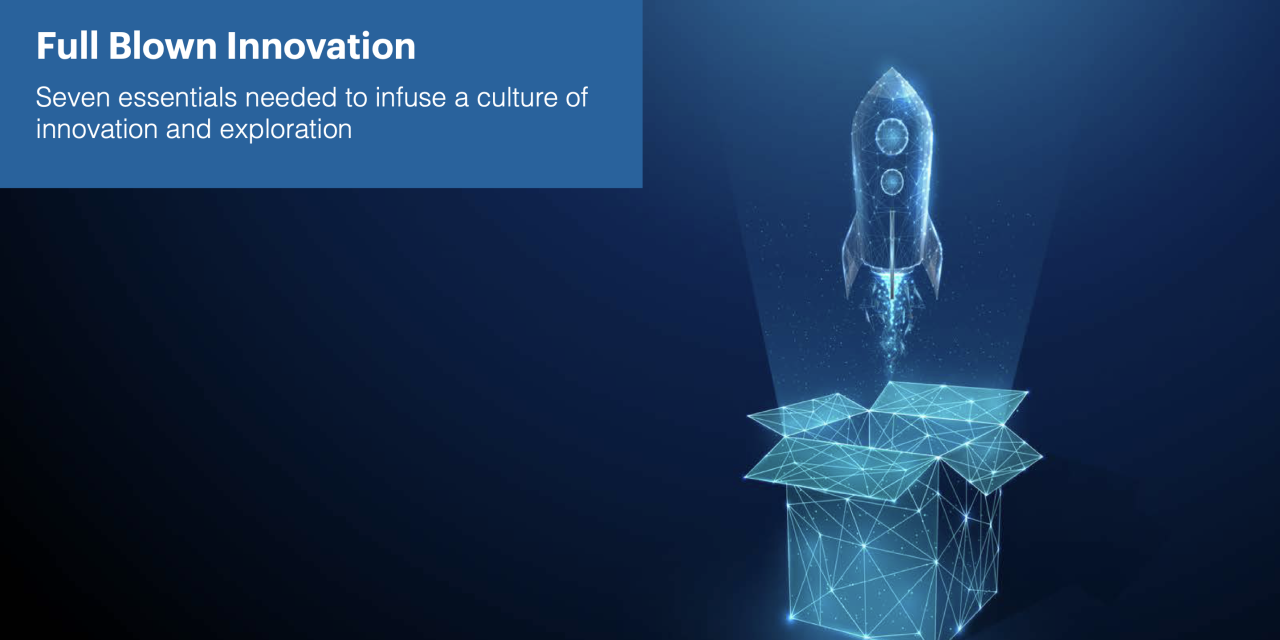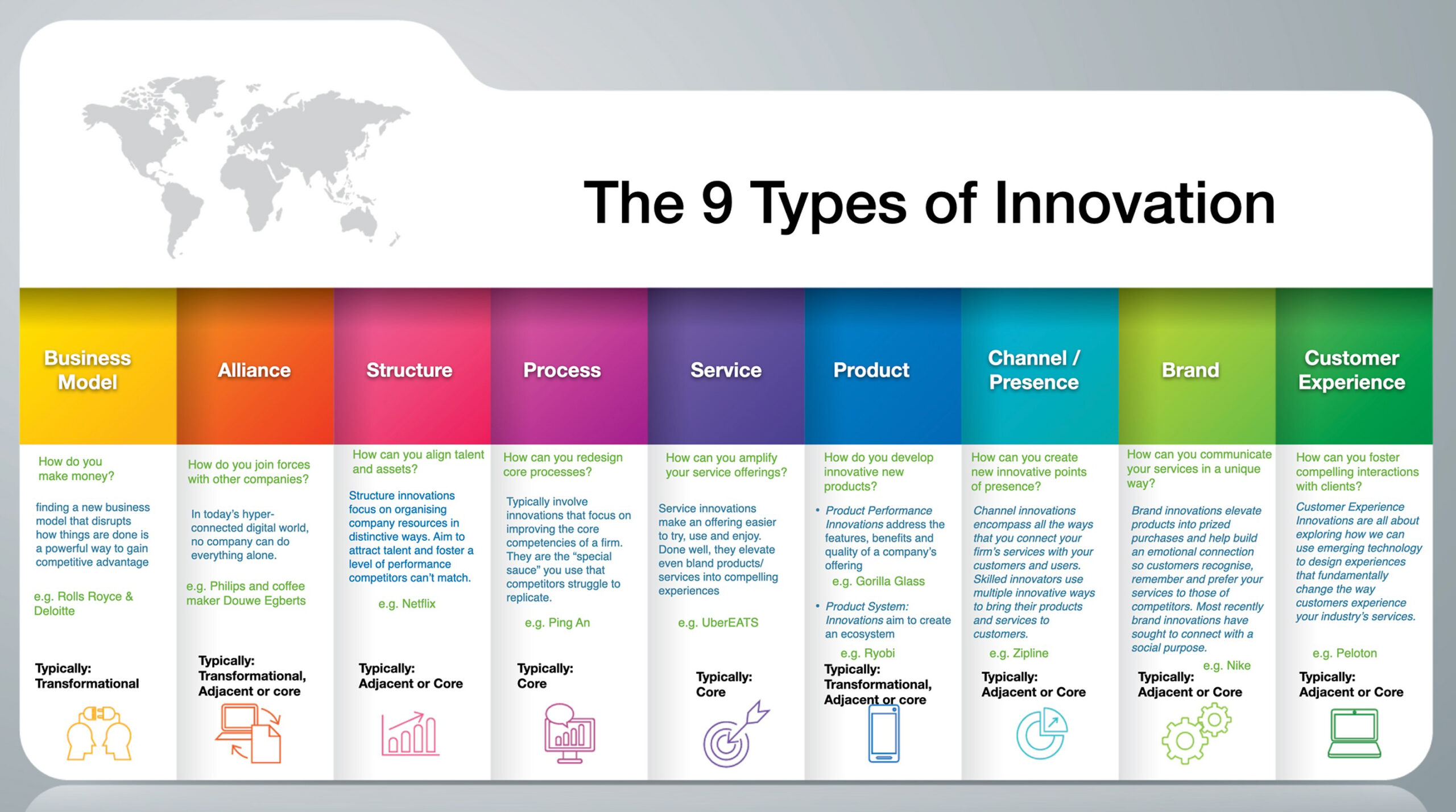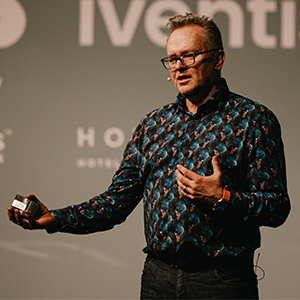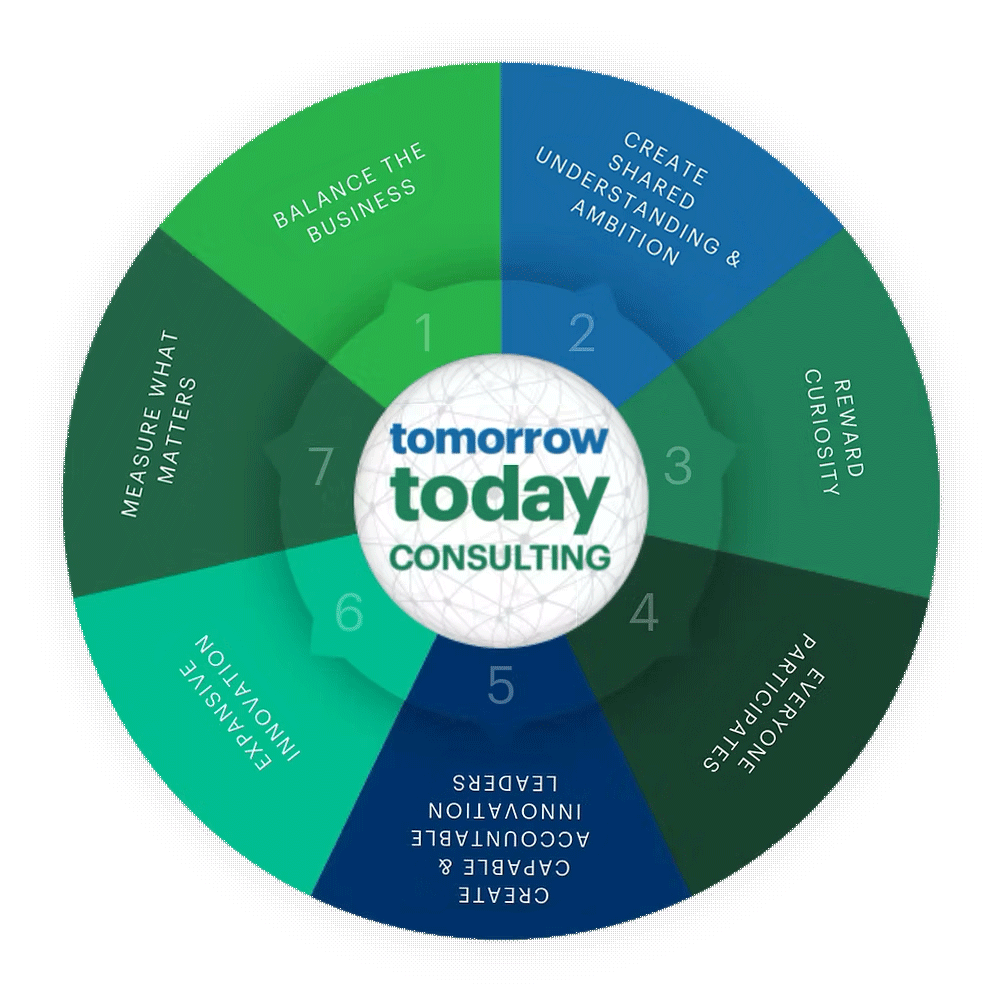
1. Introduction
Innovation is Culture
When Sebastian Thrun, the founder of Google’s innovation lab known simply as “X”, set out to design a self-driving car, he was not trying to build a better car. Thrun was exploring a very personal problem.
At the age of eighteen, Thrun lost his best friend to a road accident. This had a deep and profound impact. He decided to embark on a quest to save a million lives every year — each year over 1 million people die worldwide in road related fatalities — Most of us do not think about a world without road fatalities because there’s a part of us that doesn’t believe it is possible. Having a DNA of innovation means caring enough to believe it is possible.
Sebastian’s caring curiosity led him to realise that the solution was not a car with more airbags or crumple zones, but rather an autonomous vehicle – a radical new concept in mobility.
So, let’s confront an important misconception. Innovation is not a process, it is culture; a culture of caring combined with a culture of curiosity. No company ever became more innovative because the CEO sent out a memo or the “innovation department” held a brainstorm session.
At its core, innovation is about caring enough to solve problems that matter to your stakeholders. Innovation is not about idea generation. My dog comes up with at least two good ideas before breakfast, that doesn’t make her innovative.
When leaders focus on freeing up people to be critical thinkers who care enough to discover problems to solve, then innovation becomes the norm.
Here’s our top tip takeaway: The most innovative companies are geniuses at discovering problems nobody else has even clocked.
Steve Jobs said: “Some people say give customers what they want, but that’s not my approach. I think Henry Ford once said, ‘If I’d ask customers what they wanted, they would’ve told me a faster horse.’ People don’t know what they want until you show it to them. That’s why our task is to read things that are not yet on the page.”
That is also why Apple, Google and Tesla are the most valuable companies in the world. It’s not their ideas, it’s their leaders and culture that cares enough to discover the problems not yet on the page. Those problems most important to their stakeholders.
Innovation should not be seen as a bolt on activity. To be successful a culture of caring curiosity must be central to your organisation’s DNA.
Innovation is not that dissimilar to growing new life
A little over fifty years ago, under the inspired leadership of John F. Kennedy, humanity placed a man on the moon.
It took four-hundred thousand engineers, scientists, and other experts nearly a decade to achieve the impossible. Right now, your washing machines have more computing power than the scientist had available back then, yet we’ve never gone back. What happened?
It is related to leadership and innovation. They are compatible, but are also two very different things.
Leaders are not appointed. Leaders are followed and good leaders create the environment where people can put their ideas together and converge existing with emerging technologies to go after moonshots. Good leadership gives innovators the freedom to dream.
Indeed, innovation is not that dissimilar to growing new life. It’s a delicate thing. You must do everything to create the right environment. You put fertiliser into the ground. You give it warmth and sunlight, but not too much. You give it water, but not too much or too little either. Get it right and growth flourishes. Get it wrong and growth withers away.
Your responsibility as a leader delivering innovation in the Fifth Industrial Revolution is to ask the question: What is the right environment in which innovation will thrive?
To assist with the answer, this white paper takes the mystery out of innovation and puts forward seven practical steps which any leader can use to create a culture of exploration and innovation. We include exploration alongside innovation because together they exemplify the spirit of adventure needed to successfully innovate.
Here, you will discover an assimilation of the components of innovation that will best fit the unique nature of business in the Fifth Industrial Revolution. This paper will show you:
- How to embed innovation into your organisation’s DNA
- How to discover problems across your value chain and ecosystem
- How innovation can become everyone’s job
- Why building innovation into your organisation’s DNA is the result of focusing on aspects which at first may appear counter-intuitive. The ideas and frameworks have been formulated from TomorrowToday Consulting’s extensive research and our experience, spanning over twenty-years across almost every industry sector with clients in more than fifty countries.
We welcome your thoughts.
2. Leading for Full Blown Innovation
The ongoing viability of any organisation is dependent on its ability to continually innovate. The ones that get it right are rewarded, but most struggle to build the culture that can be relied on to yield a stream of successful innovations year-on-year.
Our research and over two decades of on-the ground experience has led us to conclude that the leaders who have the strongest innovation track record do not rely on innovation metamorphosing out of ad hoc and stand-alone efforts — each competing against one another across the business for time, money, attention, and accolades — Rather, organisations with a strong culture of innovation successfully master seven areas which together we call Full Blown Innovation:
Organisations that focus on these seven areas venture successfully on the journey towards creating a culture of innovation. We must stress these seven elements are just the start. Building a culture of innovation is a long-term commitment.
These seven elements prepare the soil and the climate your organisation needs to cultivate innovation.
2.1 Balance the business
The first part of Full Blown Innovation involves balancing ten components some which are cool and others act to stabilise your innovation culture.
Conventional wisdom suggests only disruptive, nimble start-ups can truly be innovative. The acceptance that once an entity gets bigger organisational arteriosclerosis sets in, is simply wrong.
Our research reveals that large innovative organisations do things differently. They focus on balancing five “cool” components with five stabilising components. By doing this leaders in large organisations deliver remarkable levels of sustained innovation.
The best way to think of these ten components is to imagine your organisation as a large ocean-going cruise liner like Royal Princess.
The First Part of Full Blown Innovation
Big can be beautiful
As one of the largest ships afloat, Royal Princess is a marvel of innovation. At a third of a kilometre long the ship is longer than the Manchester United, Arsenal and Liverpool football pitches laid end-to-end. The vessel’s 17 passenger decks reach a height taller than Nelson’s Column.
Arriving at the quayside to start her holiday aboard Royal Princess, a woman gazed up at her home for the next week, and proclaimed: “Beautiful! But how do they keep her afloat.” How exactly? How does she resist being blown over in a gale, or toppled by rough seas? What stops her from capsizing if the ship’s captain is forced to make a sharp turn?
Here’s the basic physics. Unlike air, water cannot be compressed, so essentially a cruise ship like Royal Princess displaces an amount of water equivalent to its own mass. The pressure of the sea pushes up against the vessel’s hull to counter the downward force of the ship’s mass. These combined forces create buoyancy.
Simple, except there is a lot more to keeping a huge vessel like Royal Princess afloat than just buoyancy.
Working behind the scenes deep in the hull and below the water line are an amazing array of stabilisers, fins and gyroscopic control systems. When the gyroscope senses the ship rolling, it changes the fins’ angle of attack to exert force that counteract the roll. At the same time, massive pumps kick in, moving water from one ballast tank to another. Combined, these innovative maritime marvels stabilise and keep the ship from capsizing.
Like the unfounded belief that big business cannot deliver sustained innovation, conventional wisdom used to say that huge ships like Royal Princess were impossible. Yet she can power up to over 26mph and make tight turns in an impressive display of nimbleness. It just requires a set of different components to those found on smaller craft.
The Royal Princess provides us with a great analogy for innovation in big business.
Above the deck are the cool components, the pools, slides, gaming rooms and restaurants. Below the deck and waterline are the balancing components – the ballast tanks and gyroscopic control systems. Together these components come together to make big powerful and beautiful.
To deliver products, services and delight clients, your organisation must manage innovation components that are “cool.” These components are widely written about and observed (it’s what you see above the water).
These five “cool” components:
- Higher social purpose
- Tolerance for failure
- Willingness to experiment
- Psychologically safety
- Organisational flatness
But just like Royal Princess, innovation in business requires a set of sophisticated stabilisers. These five stabilising components: • Innovating for profit and growth • Rigorous discipline and an intolerance for incompetence • Culture of openness and candour • Individual accountability • Strong leadership. By integrating and balancing 5 cool components with 5 stabilising components, innovation in businesses thrives.
- Innovating for profit and growth
- Rigorous discipline and an intolerance for incompetence
- Culture of openness and candour
- Individual accountability
- Strong leadership
By integrating and balancing 5 cool components with 5 stabilising components, innovation in businesses thrives.
The importance of balancing your innovation culture
When we think about innovative cultures at leading companies like Google, Apple and Uber we tend to imagine football tables, bowling alleys, free food, slides, and cosy meeting spaces with beanbags. In a copycat response, workplaces all over the world are creating similar breakout zones and gaming areas, where staff can chill out, chat, and stimulate their creative juices.
Why? Because the conventional wisdom contends that these endeavours will foster a culture of creativity with relaxed, happy, motivated, and productive employees. In addition, a vast number of leadership books will instruct you to embrace failure, experimentation, psychological safety and non-hierarchical structures because these are all attractive ‘cool’ attributes that today’s talent wants to be part of.
Yet, most companies are finding that the implementation of all these enjoyable ‘cool’ components of innovation do not result in an upswing in useful ideas. This is because what Google et al. are doing, is often misunderstood. Simply asking your organisation to be more like Google is no more realistic than ordering a French poodle to sing “La Marseillaise” whilst playing the glockenspiel.
The reason innovative cultures in big businesses often fail to deliver the expected results, is that they focus too much on the cool components and overlook the ‘below-the-deck”’counter-balancing components. Each of the ten components are now explored in more detail.
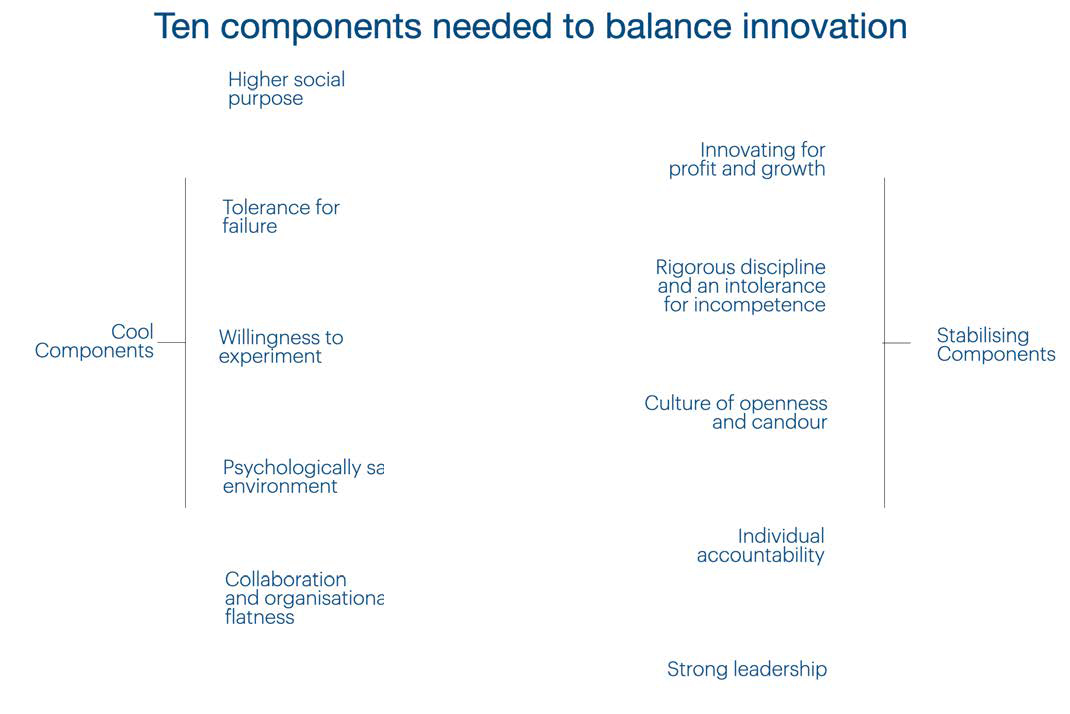


A) Higher social purpose must be balanced with innovating for profit and growth
According to Havas, a research company, 85% of people expect businesses to do more than just deliver returns to shareholders. In 2015, Fortune magazine launched its Change the World list, comprising 51 large corporations who have placed doing well by doing good at the centre of their strategies. Companies like Anglo American, PayPal, Unilever and JP Morgan grace the list. These are signals that a subtle but important shift is taking place and we are seeing the emergence of a new social contract between business and society.
CEOs of large and small companies are taking note. In August 2019, the Business Roundtable, a think-tank comprising of 181 CEOs of America’s largest companies, signed a new charter committing their organisations “to lead for the benefit of all stakeholders.”
These are shrewd business decisions. Studies show that purpose-driven companies are more ambitious, attract the best talent, inspire richer innovation, make faster decisions, are more trusted, have greater loyalty, and attract more investment.
Yet 68% of business leaders say that purpose is not used as a guidepost in leadership decision making processes within their organisation, and the vast majority of employees remain disengaged from work, and only 33% draw real meaning from their employer’s purpose.
There is a significant gap between what business leaders believe their purpose to be and what their behaviours suggest their purpose truly is. Purpose is certainly much more than a tagline. And it’s much more than a brand and communication challenge. A good purpose captures organisation’s whole sense of being. It highlights a business’ evolutionary path and it captures what an organisation aspires to be and do. The best type of purpose is not passive, or even linear: it is transformational. It is an ambition, a quest, something that the organisation and its customers can strive to achieve, together.
Of course, profit is needed to be sustainable, but profit is the result not the goal. As Jack Welch said: “On the face of it, shareholder value is the dumbest idea in the world. Profits are the result of you doing a great job… delivering better to employees and to their communities.” Importantly, Welch went on to conclude: “You’ve got to eat while you dream. You’ve got to deliver on short-range commitments, while you develop a long-range strategy and vision and implement it.”
That, in a nutshell, is the paradox between purpose and profit, which innovative organisations balance.
B) Failure and experimentation must be balanced with rigorous discipline and an intolerance for incompetence
Innovation requires people to break out and explore new ground. Therefore, a tolerance for experimentation and failure is a distinctive component of any innovative culture.
As Elon Musk says: “Failure is an option here. If things are not failing, you are not innovating enough.” Yet for all their tolerance to fail, the most innovative organisations are fastidiously intolerant of incompetence.
Musk sets the bar for performance exceptionally high, often giving design and engineering teams impossible challenges. When starting Tesla, Musk stated he wanted an electric sports car that would beat a Ferrari from a standing start. This was over ten years ago and back then electric cars were no swifter than a milk cart! A seemingly impossible quest and yet after many failures, they did it. Tesla achieves the impossible because they employ the best talent they can and are intolerant of mediocre technical skills, bad work habits, and poor management. Elon Musk is famous for micro-managing these factors but teams are given creative freedom to experiment and fail.
The caveat? Failure because of sloppy work is not tolerated. Musk knows that it is worth celebrating a prototype that fails to perform as expected because of a previously unknown technical issue, if that new knowledge is then applied to future designs. Numerous rockets have exploded or failed to land safely in the early days of Musk’s SpaceX. However, each failure was a learning that resulted in the impossible being proven possible through the re-entry and landing of a space rocket on a “postage-stamp” size platform in the middle of an ocean.
The hard truth: bringing extreme competence to any innovation initiative has to be mandatory, before teams can be given the freedom to experiment and fail.
This is the counterbalance, the gyroscopic stabiliser on your organisation’s ship. Leaders must trust that the people employed to work on projects have the level of competence required to deliver against expectation. If they do not, then staff must be re-skilled and hiring criteria changed.
It sounds obvious that companies should set high quality standards for their employees, but unfortunately too many organisations fall short in this regard.
A good starting point is for your leadership to articulate clearly the difference between productive and unproductive failures. Here, it is useful to tell internal stories so that the behaviours you seek within the network are brought to life.
Productive failures also produce valuable information and learnings relative to their cost. These failures should be celebrated and teams rewarded. The aim is to build a culture that celebrates and expresses reverence for learning, not failure.
One of our clients is the NHS, where incompetence can’t be tolerated as patient’s lives are at risk. However innovation is encouraged because it leads to solutions that result in more lives saved in an environment of increasing healthcare demands and decreasing budgets.
Building a culture of experimentation and competence requires:
- Clearly articulating expected standards of performance and capability. Without well understood expectations, difficult personnel decisions can appear whimsical or – worse – culturally destructive, when misinterpreted as punishment for a failure.
- Senior leaders and managers should regularly communicate and role model expectations.
- Recruitment standards may need to be raised, even if that temporarily slows the growth of the company.
Maintaining a healthy balance between tolerating productive failures and rooting out incompetence is not easy. Everyone makes mistakes, but at what point does tolerance slide into laxness? At what point does setting too high-performance standards strangle innovation?
All innovation requires experimentation. Thus it is important that experiments are carefully chosen on the basis of their potential learning value. Focus too needs to be on designing the experiment to yield as much information as possible, as quickly as possible, and at as low a cost as possible. It is also important to set up the parameters for the experiment, otherwise it becomes difficult to decide whether to move forward with, modify, or kill an experiment. The irony is, being disciplined about being quick to kill projects makes it easier to try new things.
Experimentation typically leads to a complex cultural challenge. Few leaders are comfortable with the notion of themselves or their team failing and thus experiments rarely happen unless they are safe. But that defeats the purpose of building a culture of innovation. The solution lies in shifting the focus and attention away from the experiment’s failings and to its learnings.
-
What can our organisation do to help people unlearn and relearn new skills?
-
What skills will be valuable to our organisation in the future?
-
What skills will become obsolete?
-
What new skills will be required?
-
How can our organisation differentiate between failures that have resulted from incompetence versus those that genuinely didn’t work out?
-
To what extent do we encourage and allow our people to experiment?
-
Are our experiments conducted within a framework of rigorous discipline?
-
Do our people understand the parameters for making decisions on when and which experiments to kill?
-
As breakthrough technologies like Blockchain, AI and robotics are adopted more and more, business models will be transformed. As this happens, people who are competent employees in one context may be rendered incompetent in another.
-
Consider how digitisation and advances in data analytics has already impacted the value of different skills within your industry.
-
In some cases, people can be retrained, but this is not always possible. Keeping people who have been rendered obsolete may be compassionate, but it’s culturally dangerous for the innovative organisation.
Reflection Points
Questions to Consider
(C) Psychological safety must be balanced with openness and even brutal candour
- Like most leaders, Google executives believed that the best teams were those that had the best people — the right people, on the right bus. But according to Julia Rozovsky, people analytics and HR strategy manager at Google: “we were dead wrong.” A two-year long study of 180 teams undertaken by Google discovered that one trait — psychological safety — stood out and was shared by their most successful teams. Most organisational cultures are cloaked with a veneer of fear. The fear of failure, fear of challenging the boss, fear of speaking up, etc. These fears can immobilise individuals and teams and prevent them from achieving their best.
Imagine a different environment. Imagine a work place where people feel safe to take risks, voice their opinions, do things differently, openly challenge anyone regardless of seniority and ask judgment-free questions. A culture where leaders provide air cover and create safe zones so employees can let down their guard. This is what Harvard professor of leadership and management, Amy Edmondson calls “psychological safety.”
Psychological safety is defined as an organisational culture in which individuals feel they can speak truthfully and openly about problems without fear of reprisal. Psychological safety, Edmondson says: “not only helps organisations avoid catastrophic errors but also supports learning and innovation.” Her studies are supported the Google study’s discoveries. Rozovsky says that teams with “psychologically safe environments had employees who were less likely to leave, more likely to harness the power of diversity, and ultimately, who were more innovative and successful.”
Amy Edmondson describes building a psychologically safe culture in three steps:
- ‘Frame the work’ – tell people why: This is the purpose. People, especially millennials, want to know why they should get out of bed and care about what they are being asked to do, over and above getting a pay cheque. Your organisation should explore and answer why you are asking people to be more innovative? What is your organisation’s narrative and is this narrative the same across organisations? Is it company survival and success, is it customer satisfaction, or is it to build competitive advantage? The accounting services company Ernst & Young has framed innovation under the context and purpose of “creating a better working world.” This is motivational and pulls teams, clients and projects together. The answers behind ‘Why is innovation important for your organisation?’ will help to create a shared goal that overrides individual egos and silos.
- Invite Engagement – ask people to get involved. Be open. Ignore hierarchies. Crowdsource, get diverse views and input. Let people’s voices be heard. Intent here is very important – the intention of engagement is to achieve the purpose of the work.
- Respond productively – show you are listening and hearing. Show you are taking action on what you’re hearing. Show that it’s worth speaking up and being heard. Show that the behaviours you are seeking to encourage can work here, e.g. it’s okay to fail (in innovation). The goal is to achieve your purpose with maximum energy and input from everyone, so that they can flourish in a safe environment and bring their best selves to work.But psychological safety is only one side of the coin. The other side is brutal or ‘radical’ candour and this is an essential part of building a culture of innovation.Brutal candour encompasses practices to get, give and encourage guidance and feedback at work (both praise and criticism), and can help build cohesive teams. “It’s not a license to act like a jerk. It’s not an invitation to get creepily personal. It’s not just for managers, bosses, or those in a position of authority — we all want to succeed,” says former Google and Apple executive Kim Scott.Giving open, honest feedback with good intent has the impact of improving individual, team and organisational performance. For example, in our work in big pharma and with the NHS, we found that teams with nurses who felt safe speaking up about problems mastered new innovative surgical approaches fastest. Often, in business feedback is not given or received well. If feedback is given because you care about the other person succeeding or your care about the idea succeeding, then it’s welcomed and encouraged.
Of course, the ‘how’ brutal candour is given is as important as the ‘what’. If people are afraid to criticise, openly challenge superiors’ views, debate the ideas of others, and raise counter perspectives, innovation can be crushed. However, in an environment where people feel safe to experiment, to fail, to speak up and to be supported and supportive, then innovation can thrive.
Questions to Consider
Reveal-
Does your organisation have an open and candid culture?
-
Are your people skilled at and encouraged to give and receive feedback?
-
Do staff feel safe to speak up?
-
Have you clearly articulated the ‘why’ of innovation?
(D) Organisational flatness must be balanced with individual accountability
Have you noticed how when decision making processes are unclear, the accountability ends up in the middle of the table with no individual feeling the need for delivery? As a result, innovation is squashed.
Leaders should facilitate a culture of innovation by publicly holding themselves accountable as well as demonstrating the willingness to collaborate. This takes courage because the results sit with leadership, not the team working on the innovation. But if you point the finger back to specific employees or teams, it will likely stifle all innovation.
Questions to Consider
Reveal-
Are decision making processes clear and communicated?
-
Are decisions pushed down to the lowest level possible to increase accountability?
-
How are people held accountable for their actions?
(E) Flat hierarchy must be balanced with strong leadership
Organisational charts provide an overview of the chain of command and structure of organisations, but they reveal little about the cultural flatness – an observation of behaviours and interactions regardless of official position. In culturally flat organisations, people are expected to take actions, make decisions and voice their opinions. Leadership is granted informally on the basis of respect and competence, not title. These leadership roles change from one project to the next. Our studies show that culturally flat organisations are more agile because decision making is decentralised and closer to the sources of relevant information. Organisations with flat cultures tend to generate a richer diversity of ideas than hierarchical ones, because they tap the knowledge, expertise, and perspectives of a broader, more passionate and committed community of contributors.
In innovative organisations, a lack of hierarchy does not mean a lack of leadership. On the contrary, flat organisations require even stronger leadership than hierarchical ones. Flat organisations often devolve into chaos when leadership fails to set clear strategic priorities and directions.
One of our clients, Investec Private Bank is known for being culturally flat. Decision making and accountability are pushed down and employees at all levels are expected to exercise a high degree of autonomy to pursue innovative ideas. Yet at the same time the bank has incredibly strong and visionary leaders who see it as their role to be highly visible and accessible. They spend a large portion of their time communicating goals, reinforcing organisational values and articulating key principles that support culture and strategic direction. Investec combines a flat structure with a focus on internal mobility. They seek passionate and energetic individuals with an entrepreneurial spirit and a desire to learn and collaborate.
At Investec, senior leaders understand that a deft hand is required to balance flatness and strong leadership. They have visible cultural symbols and processes that reinforce and illustrate this flatness. Senior leaders work with colleagues in open plan offices with ‘pulse rooms’, where they have visibility of operational details and projects. Once a month, executive directors take junior talent for a meal or a drink. Co-founder and former executive director Bernard Kantor believes it is Investec’s flatness which gives the organisation its competitive advantage because their leaders are closer to the action. “We can’t compete on our balance sheet,” Kantor says, “but the quality of our employees (attracted by our innovative culture) is exceptional and we’re not bogged down by hierarchies. We’re flexible and quick but equally we are balanced and riskconscious. I really believe that working for us is the closest someone will get to running their own business within an institution. You’ve got to be entrepreneurial, you’ve got to take the ball and run.” He adds: “We began with nothing, but we learned two things. We had to be tight on culture and values. And, we taught ourselves how to integrate people into a very flat structure that is based entirely on meritocracy. Anyone can say what they like to anybody. They have complete access to the CEO.”
Our discussions with Investec’s leadership show that getting the balance right between flatness and strong leadership is equally difficult for top management as it is for employees throughout the organisation. For senior leaders, it requires the capacity to articulate compelling visions and strategies while simultaneously being adept and competent with technical and operational issues. For employees, flatness requires them to develop their own strong leadership capacities and be comfortable with taking action and being accountable for their decisions.
Questions to Consider
Reveal-
How can we develop our leaders to thrive in a culturally flat organisation?
-
How can we encourage even more collaborative behaviours and operate as a more flexible, agile organisation?
-
How aligned is our formal structure (our ‘hard wiring’) with the behaviours we need to need to thrive (the ‘soft wiring’)?
-
How could we learn from other, similar organisations?
2.2 Create shared understanding and ambition
The second part of Full Blown Innovation involves creating a shared understanding of your innovation ambition.
Successful innovators are experts at clearly communicating their innovation ambition. So, an important step in building a culture of innovation is to agree your end game:
- Do you want to disrupt or transform?
- Does your strategy require entering new or adjacent markets?
- Do you want to focus on core (process) innovations?
You can do all three, but the executive team must agree on the ratio of the ambition, because this drives the kind of culture you need to build.
The Second Part of Full Blown Innovation
In the late 1990s, a struggling Apple made this decision: To bet boldly its business on several big initiatives, including the iTunes platform. This transformation paid off handsomely. Conversely, IBM wanted to retain its leadership position in a market that had cooled by removing some risk from its portfolio, and shifted its emphasis from transformational to core initiatives.
It is important to find the right innovation ambition balance for your organisation, and this can only be achieved through significant analysis of your current culture, attitude towards risk, competitive position and speed of change in your industry (and adjacent industries).
All these have an influence on determining the required and Review article: Managing Your Innovation Portfolio. This model helps organisations determine “Where to Play” and “How to Win.” The vertical axis explores where a organisation wants to compete – ranging from serving existing customers, entering adjacent markets, or creating new markets. The horizontal axis desired level of innovation ambition. For example most companies have an ambition ratio of 10:20:70, where 10% of resources are allocated towards breakthrough or transformational innovations, 20% towards adjacent, and 70% to core innovations. Conversely, a disruptive start-up may have a ratio of 70:20:10 with 70% of resources focused on transformation.
The overarching dimensions of innovation were developed by Bansi Nagji and Geoff Tuff using the Innovation Ambition Matrix (see diagram) which they wrote about in the Harvard Business Review article: Managing Your Innovation Portfolio. This model helps organisations determine “Where to Play” and “How to Win.” The vertical axis explores where a organisation wants to compete – ranging from serving existing customers, entering adjacent markets, or creating new markets.
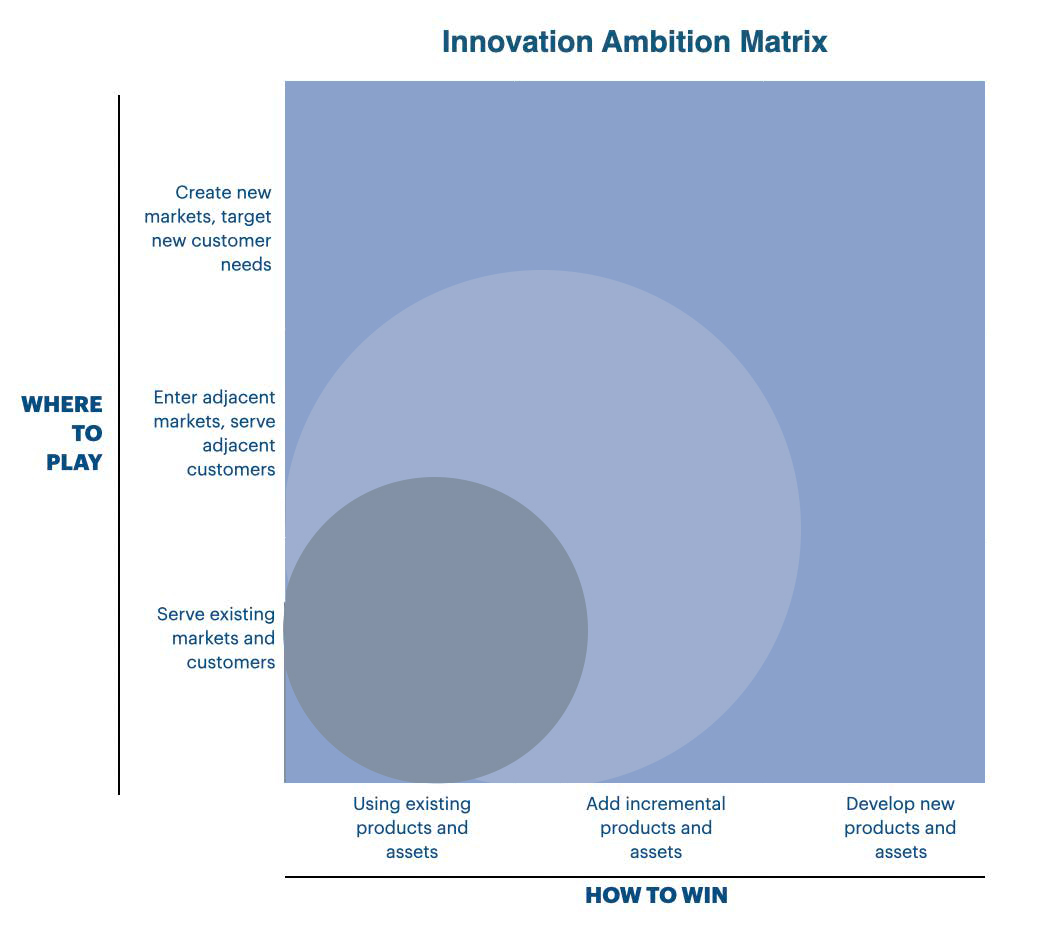
Transformational
Developing breakthroughs and inventing things for markets that don't yet exist
Adjacent
Expanding from existing business into new or adjacent markets
Core
Optimising products, services and processes for existing customers
The horizontal axis explores your innovation ambition by questioning whether you are using existing, adding incremental or creating new products or services.
Studies reveal that most companies’ allocation of resources follows a 70/20/10 innovation ambition ratio. 70% of investments go to core or process innovations, 20% for adjacent and 10% for transformational innovations.
What does your innovation ambition ratio look like? Answering this is an important starting point for building an innovation culture.
Studies also show that the returns in high-performing companies follow the inverse of the resource allocation ratio with core innovation efforts typically contributing 10% of the long-term, cumulative return on innovation investment, adjacent initiatives contributing 20%, and transformational efforts contributing 70%.
Many businesses get caught up in the trap of investing mainly in what they know best: their core business. But focusing primarily on core innovation risks a steady decline in business and relevance to customers.
Transformational initiatives might be the engines of epic growth but they can be inherently risky and even sink a business if allocated too much focus. The balance between core, adjacent and transformational innovation is known as the ‘innovators dilemma’.
The most successful organisations are able to execute across all three levels of innovation ambition. Targeting a healthy balance of core, adjacent, and transformational innovation is a vital step toward building a culture of innovation.
Finally, it helps to articulate high level strategic ambition with estimates of the value that innovation should generate to meet financial growth objectives. To build a culture of innovation, innovation must be an explicit part of your strategic plans. Innovation targets for growth must be set by the Board and CEO.
These targets need to be large enough to encourage innovation strategies in your organisation’s plans. If teams can make their numbers using other less risky tactics our experience suggests they will. But, by analysing the nine types of innovation, organisations are better positioned to explore and identify where innovation opportunities might exist and thus better focus their innovation ambition.
2.3 Reward curiosity
The third part of Full Blown Innovation involves valuing curiosity over creativity. Here’s the thing, the most innovative organisations are not more creative or even any better at solving problems.
What sets them apart is their uncompromising desire to explore and discover new problems to solve.
The Third Part of Full Blown Innovation
When most leaders say that they are investing in innovation, they turn to large initiatives for idea generation. They will highlight the latest hackathons and the many great ideas. There is however, a problem with this approach: Generating lots of creative ideas is not innovating.
Innovation needs to begin with identifying the big problems in your customers’ worlds. This may sound obvious, but great innovators know that problems are cloaked in what looks and is often widely accepted as ‘normal’.
It is important to recognise where great innovative ideas comes from. For Sebastian Thrun, the big problem was how to end road fatalities. His curiosity led him to explore nascent technology and his radical solution, autonomous self-drive cars became obvious.
We accept road accidents as an unfortunate normal of modern life.
But, for the explorer it does not need to be this way.
The most powerful way to build innovation into your organisation’s DNA is to build a culture where people constantly challenge the status quo, seeking answers to the question: “What big problems lurk hidden within the normal of our customers’ world?“
Here’s the thing – the most innovative organisations are not more creative or even any better at solving problems than their peers. Rather, what sets them apart is their uncompromising desire to discover new problems to solve.
The 21st century is full of problems just waiting for innovative entrepreneurs and intrepid organisations to strike out and find new ground.
By building a culture that values curiosity more than ideas, you will begin to develop the mindsets needed to be adaptable and solve the meaningful problems that your people – clients and employees – care most about.
2.4 Everyone participates
The fourth part of Full Blown Innovation involves inviting everyone to participate.
Too many people think that innovators are the Einstein-haired crazy thinkers who come up with genius ideas. While those people are certainly important to innovation, that’s not actually how innovation works.
Companies that deliver innovation well ensure that everyone feels part of the process and that everyone knows their place and role in that process – including the person who always says, ‘no, this will never work,’ because, sometimes, they are right.
The Fourth Part of Full Blown Innovation
Think of Thomas Edison and the light bulb – this has become the very symbol of innovation. And yet, Innovation is not about a “light bulb moment” – it’s about the whole process. It was Edison who conceived of the idea of a lightbulb, the crazy idea that electricity would result in light (it’s not that difficult – electricity produces heat, and lots of heat produces light. The trick is to get it to just the perfect point where there’s light, but not so much heat that everything melts or burns up). Edison then hired a small army of technicians to experiment with different approaches. No-one knows how many experiments they tried, but it was certainly hundreds if not thousands — This group of technicians are also innovators and a good Chief Innovation Officer would give them a lot more credit than Edison ever gave his team.
When finally, they had their breakthrough and discovered what worked, the “lightbulb moment” happened. But this was still not the end of the innovation cycle. If they had stopped there, we still wouldn’t have lightbulbs today. Edison turned next to a group of engineers, who had to devise a way to make lightbulbs at scale – lots of them, as cheap as possible. This part of the innovation process is often overlooked, but it’s vital: making sure the great idea can be replicated, scaled and actually used.
Henry Ford’s Model T assembly line is one of the most famous of all “process innovations”. The people who come up with these parts of an innovation are not often hailed as innovators – but they should be.
Once Edison’s factory was churning out lightbulbs, he still needed at least two more groups of people to help him deliver his innovation to the market: logistics and marketing. Building a delivery infrastructure and convincing people to actually buy the product are critical components of delivering innovation.
It’s not a perfect analogy, but we hope it makes the point: too much energy is focused on the initial crazy idea, and not enough effort – and praise – given to the many other parts of the innovation process.
As we can see from these examples, there are many different roles people can play. We refer to the process of ensuring everyone understands their role as: Invitational Innovation. Indeed there are up to ten roles which can be played in building a culture of innovation Tom Kelley and Jonathan Littman identify the following different styles of innovative thinking. When building a culture of innovation it’s important that people understand the different roles they can play:
- Anthropologists: Anthropological researchers immerse themselves in alien cultures and observe carefully. This sort of intense observation is the single greatest source of innovation you can bring to your organisation. Zen Buddhism calls this “the beginners’ mind”.
- Experimenters: Experimenters are persistent about solving problems. They try lots of prototypes, make drawings, and build and test models. Then, they take what they learn and start all over again.
- Cross-Pollinators: Cross-pollinators bring together disparate things.
- Hurdlers: Hurdlers specialise in overcoming obstacles. You can’t defeat them by blocking the direct path to their goal – they’ll jump over it or work around it. Hurdlers treat every obstacle as an opportunity.
- Collaborators: Collaborators not only work well with others, they also generate connections among other people. They encourage teams from different disciplines to work together and work among parties to keep everyone on the same page.
- Directors: Directors are planners and organisers.
- Experience Architects: Experience architects present ideas by appealing to the senses. They’re interested in aesthetic pleasure as well as understanding.
- Set Designers: Set designers focus on making physical space both functional and pleasing.
- Caregivers: Caregivers have the ability to put people at ease, but their main concern is providing good service.
- Storytellers: Unlike facts, stories forge emotional connections between the teller and the audience. Storytellers can take the ordinary and reshape it into something special, creating inspirational myths and allegories.
Companies that do innovation well ensure that everyone feels part of the process, and that everyone understands their role – including the person who always says, ‘but this will never work,’ because, sometimes, they are right.
2.5 Create capable and accountable innovation leaders
The fifth part of Full Blown Innovation involves creating capable and accountable innovation leaders.
Too often innovation is left to specialised units like the innovation lab or corporate R&D rather than being the responsibility of every leader. If leaders are not made formally accountable for innovation and have innovation-related targets that affect their compensation, a culture of innovation will be marginalised.
Naturally, it makes little sense to hold leaders accountable for innovation if they haven’t been trained and coached to encourage innovation within their own teams. Through selection, training, and feedback, successful organisations create a cadre of leaders who are as adept at fostering innovation, as they are at running the business.
The Fifth Part of Full Blown Innovation
Any cultural change is challenging but committing to the journey of building and sustaining a culture of innovation is particularly difficult, for three reasons:
- Innovative cultures require the combination and balancing of ten seemingly paradoxical components. If not managed carefully they risk creating confusion.
- Some of the ten components required in building a culture of innovation are relatively easy to embrace, others are less palatable. People who view innovation as a free-for-all will see the necessary rigours of discipline as a constraint to their creativity. Some people will resist a shift toward individual accountability. When taken as a whole, some people will readily embrace the ten components of innovation and the new rules they require. But others will not thrive. It should therefore not be surprising, that there will be people inside your organisation, particularly those thriving under the existing culture, who will resist. Leadership needs to be ready for this, otherwise things will remain business as usual.
- Innovative cultures cannot be implemented in a piecemeal fashion. They require a systematic approach to co-ordinate interdependent behaviours. We’ve listed ten components that require thoughtful management and explored how these components need balancing in order to complement and reinforce one another within your organisation.
ACTION
- All senior leaders need to be educated as to what innovation means and how this impacts behaviours and expectations
- Develop a Senior Leadership Innovation L&D programme. This programme should be mandatory for all senior leaders
- Build innovation behaviours into the recruitment and selection processes for new leaders coming into the organisation or being promoted internally.
Things leaders can do to support a culture of innovation
Beyond the usual things that leaders can do to drive cultural change (articulate and communicate desired values, model target behaviours, and so on), building a culture of innovation requires specific actions.
- Be very transparent with your people about the harder components of innovative cultures. Innovative cultures are not all fun and games and some people may not fit as the new culture unfolds. In our experience, some people will be excited about the prospects of having more freedom to experiment, fail, collaborate, speak up, and make decisions. For others, this will mean less structure and mor e ambigui t y combined wi t h greater responsibilities. The best thing to do as a leader orchestrating change towards building a culture of innovation is be up-front right from the get go. Anything less risks cynicism and distrust.
- Recognise that there are no shortcuts in building a culture of innovation. Too many leaders think that by launching an innovation lab or holding lean sprints and hackathons, they can emulate a culture of innovation. Rarely does this approach work. Innovation is not a thing; it is not a new product. Building a culture of innovation requires systematic execution, understanding the type of innovation and leveraging the components that lead to a culture of innovation. Without strong management efforts to shape values, norms, and behaviours, any efforts to cultivate a culture of innovation will fall on hard ground. This does not mean that autonomous units or innovation labs shouldn’t be used to experiment or to incubate a new business idea. They can, but they need an environment that will help them to flourish. The challenge of building innovative cultures across the organisation should not be underestimated and there is always the very real risk that isolated innovation initiatives will not scale.
- Innovation is a balancing act and leaders need to be vigilant for signs of excess in any area and intervene when necessary. Unrestrained, a tolerance for failure can encourage sloppy thinking, and too much intolerance for incompetence can create fear of exploring and risk taking. Neither extremes are helpful. Collaboration taken too far can slow down decision making, but excessive emphasis on individual accountability can result in reinforced silos and protecting one’s own interests. There is also a difference between being candid and just being plain nasty. Leaders need to be vigilant for excessive tendencies.
For your organisation to strike the balance required, senior leaders need to be educated and trained to fully understand the requirements and must also demonstrate the ability to strike that balance themselves.
2.6 Expansive Innovation
Type 1: Business Model Innovation
Business model innovations are also known as innovative profit models. These innovations challenge conventional industry orthodoxies of how a ‘normal’ company operates. In most industries, the dominant profit model often goes unquestioned for decades. Finding a new business model that disrupts how things are done is a powerful way to gain competitive advantage.
EXAMPLE — The “power-by-the-hour” business mode: One of TomorrowToday’s clients, British marine and aircraft engine manufacturer Rolls-Royce, offers a compelling example of this type of innovation with their shift to a “power-by-the-hour” business model. Before the innovation, Rolls-Royce was exclusively a product business. For a large one-off sum, the organisation sold an engine to an aircraft or ship manufacturer.
The new business model shifted the organisation’s approach from selling engines to selling thrust hours. The new business model also brought Rolls-Royce closer to the end-user. This was genius as it aligned the business operations with the job (outcome) the end customers actually wanted from the product. This strategy is now attributed to Rolls-Royce having a broad customer base comprising more than 500 airlines, 4,000 corporate and utility aircraft and helicopter operators, 160 armed forces, more than 4,000 marine customers, including 70 navies, and energy customers, in more than 80 countries. Annual underlying revenue was £14.3 billion in 2018, of which more than half of the company’s revenue came from the provision of services. The organisation’s order book stood at £63.1 billion, providing visibility of future levels of activity.
Another example comes from one of our other clients, professional services firm Deloitte, who noticed their clients’ desire for assurance that the advice they were being given and transformation projects they were running would actually succeed.
Deloitte has begun trialling projects where instead of basing their fee only on time and materials, they will also share in value delivery, where additional bonus payments are activated only when previously-agreed performance metrics are successfully met.
This shift to a value sharing business model makes Deloitte a genuine partner in their client’s success and represents a significant shift away from input based fee models.
Type 2: Alliance Innovation
How does your organisation join forces with other companies for mutual benefit and customer delight?
In today’s hyper-connected digital world, no company can do everything alone. As AI, robotics, Blockchain etc. move mainstream, alliance innovations will become even more important.
Alliance innovations provide a way for organisations to take advantage of other companies’ processes, technologies, offerings, channels and brands.
This type of innovation also helps organisations to share risk in developing new offers and ventures.
EXAMPLE — The coffee alliance: Senseo, a coffee brewing system, is an innovative alliance between electronics company Philips and coffeemaker Douwe Egberts. The innovations resulting from the alliance became so successful that they were given a name: ‘The Senseo Effect’.
Type 3: Structure Innovation
How do you innovate to organise and align talent and assets? Structure innovations focus on organising company resources – intangible, physical and human – in distinctive ways that create value. They can include everything from how AI is used to recruit new talent to how teams are structured across the network to deliver customer solutions. Structure innovations aim to attract talent by creating desirable working environments or fostering a level of performance and productivity that competitors can’t match.
EXAMPLE: Netflix – Unlimited Holidays: To retain and attract talented people in the highly competitive Silicon Valley, Netflix reviewed their formal HR policies to see what processes were getting in the way of people doing their best work. They discovered that many processes were in place to only handle situations where a low-performance individual would do something wrong. Whilst well intended this red tape was hindering high performing individuals. The bold decision was taken to scrap formal HR policies, freeing up people to have the freedom to work in their own ways to benefit the business. Captured in their now legendary “Freedom and Responsibility” culture document, the innovation includes allowing staff to take as many vacation days as they felt they needed to produce their best work.
Type 4: Process Innovation
How can you redesign core operating processes to improve efficiency and effectiveness?
Process innovations typically involve innovations that focus on improving the core competencies of a organisation. Ideally, they are the “special sauce” you use that competitors struggle to replicate. These innovations have the ability to dramatically transform ‘business as usual’, enabling organisations to use unique capabilities, adapt quickly, and build market–leading margins.
Example: Ping An – putting a zing into insurance claims In 2017, Ping An, China’s largest private-sector company, rolled out their “Superfast Onsite Investigation” process, enabling policyholders to submit claims by simply opening a smartphone app and answering a few questions. Before this even minor fender benders used to mean endless hassle for drivers who could wait hours by the roadside for an insurance inspector, then lose even more hours filling out forms.
Customers now used the Superfast Onsite Investigation claims process to settle 7.3 million claims, or 62% of the total. The innovation, which uses sophisticated artificial intelligence and data-processing operations, saves the company more than $750 million each year by reducing bogus claims and human error.
To generate accurate estimates, Ping An matches photos of vehicle damage against a database of 25 million parts used in the 60,000 different auto makes and models. The system assesses whether those parts can be repaired or must be replaced, then calculates the cost of parts and labour in more than 140,000 garages. Ping An integrates all that information with face, voice, and image recognition tech and a complex matrix of anti-fraud rules.
Ping An chief scientist Xiao Jing says it took a team of A.I. experts, data scientists and insurance managers three years to design, develop, and integrate the new service. It is, he exults, “the only one of its kind in the world.”
But the app’s neatest feature offers the option to not even wait for an inspector. Instead, customers can snap photos of a damaged vehicle and send them to a Ping An computer, which can respond with a repair estimate in three minutes or less. If the customer accepts the estimate, then wancheng! (“done!”) Ping An transfers funds immediately.
Type 5: Service Innovation
How can your organisation support and amplify the value of its offerings?
Service innovations make a product easier to try, use and enjoy. Done well, they elevate even bland commoditised products/services into compelling experiences that customers come back for again and again.
Example: Uber – Eating the competition: Uber has already transformed the taxi industry with its innovative approach to transportation. Now Uber is disrupting the adjacent food delivery market with UberEATS, an innovative online food ordering and delivery platform that leverages off the existing Uber infrastructure and services. UberEATS is also extending operations into ‘cloud kitchens’ and grocery deliveries. By 2018, just 3 years after its launch sales had already exceeded $1.4bn up 149 percent from the previous year.
Type 6: Product Innovation
How can you redesign core operating processes to improve efficiency and effectiveness?
Too often Product Innovation is mistaken for the sum of innovation. It’s certainly important, but it’s only one type of innovation. It’s also the easiest for competitors to copy. Too quickly, we see product innovations devolve into an expensive mad dash to parity. This is the dilemma Apple currently faces with the iPhones. Product innovation can be divided into two areas: product performance and product system innovations.
Product performance innovations address the features, benefits and quality of a company’s offering. This type of innovation involves both entirely new products as well as updates and line extensions that add substantial value.
Example: Gorilla Glass – the chemistry of selfies and pocket fumbles: Gorilla Glass is a brand of chemically strengthened glass developed and manufactured by Corning and used as the glass adorning most smartphones. The 5th generation glass was highly acclaimed for its innovative “selfie height” shatter resistant chemistry. The 6th generation addressed another customer pain point – the “fumble drop from your pocket height”. This product performance innovation uses chemistry that makes the glass resistant to cracking after 15 drops from a lower height. Great product innovations do not just try to become incrementally better. By resisting to innovate a single drop from an even higher height solution, Corning instead figured out what really matters to customers and delivereda solution that addressed their biggest problem – the multiple lower height fumble.
Product system innovations aim to create an ecosystem of complimentary products and services that when bundled together create a robust and scalable system. This is cultivated through interoperability, modularity, integration, and other ways of creating valuable connections between otherwise distinct and disparate offerings.
Example: Ryobi – One battery to rule them all: While the move to cordless machines is great, having multiple expensive battery packs is not. Ryobi, a power tool company, addressed this problem by designing the One+You – a single battery designed to be integrated and used with over 100 different tools. Not only was this good for the environment and more convenient for customers, it also incentivises customers to embrace the Ryobi tool ecosystem over competitor products.
Type 7: Channel or Presence Innovation
How can your organisation create new innovative points of presence?
Channel innovations encompass all the ways that you connect your firm’s services with your customers and users. Skilled innovators in this type use multiple innovative ways to bring their products and services to customers.
Example — Drone technology that saves lives: Zipline, an American medical product delivery company with a focus on providing services in Africa, uses artificial intelligence, drones, machine learning and robotics to provide the rapid delivery of vaccines, blood, and drugs. Using drones as an innovative delivery channel, Zipline has developed a simple, reliable delivery network where hospitals in Rwanda and Ghana can order medical products from a central distribution centres and receive medical supplies within an average of 15 minutes, rather than the hours or days it used to take. Founded in 2011 and valued at 1.2bn, Zipline has plans to expand services upstream into the US. Zipline’s moonshot, says co-founder and CEO Keller Rinaudo, is to put every person on Earth within a 15- to 30- minute delivery radius of any essential medical product they need, no matter where they live.
Type 8: Brand Innovation
How can your organisation communicate your services or products in a unique and value-added way?
Brand innovations can elevate commoditised products into prized purchases and help build an emotional connection with customers so they recognise, remember and prefer your services to those of competitors. Most recently brand innovations have sought to connect with a social purpose. For these innovations to work, credibility in actions is more important than words, even if this means the bottom-line is impacted in the short-term.
Example: Being willing to lose customers who don’t align with purpose: As a protest to police brutality former NFL Quarterback Colin Kaepernick kneeled rather than stood during the US national anthem. Nike choosing to align with the values of ending inequality and violence, made Kaepernick the face and voice of their brand in the “Believe in something. Even if it means sacrificing everything. Just Do It” campaign. This led to some people burning their Nike trainers and even Donald Trump took to twitter saying: “it’s a terrible message.” The brand innovation paid off. Nike’s stock surged to an all-time high and online sales jumped 31%.
Type 9: Customer Experience Innovation
How can your organisation foster compelling interactions with clients?
Customer Experience Innovations are all about exploring how we can use emerging technology to design experiences that fundamentally change the way customers experience your industry’s services. The best innovators discover new ways to make experiences more memorable, impactful, and even magical.
Example: Immersed real-time high-energy cycling:
The problem with spin cycling was firstly you had to join an expensive gym, then fit in with the gym’s schedule, not yours, and leave your office or home to get there. But what if you could have the best most inspirational spin instructors, the real-time motivational input of spinning with 1000’s of other cyclists from around the world, using high quality equipment and all this from the comfort of your home? This is the innovative experience that Peloton, an American exercise equipment and media company which was founded in 2012 by Harvard Business School graduate John Foley. Described as the Netflix of exercise, today Peloton has a valuation of over $4 billion and subscription revenue of exceeding $700 million and growing fast, all because of the awesome and immersive experience new technology has enabled the company to bring directly to your living room. Whilst spin cycling can seem far removed from the world of auditing and advisory services, the question to ask is: How can you use breakthrough technology to fundamentally change what your customers experience? You may also discover that answering this question opens up new markets.
2.7 Measure what matters
The seventh part of Full Blown Innovation involves measuring what matters most. “Culture eats strategy for breakfast” is a famous quote from legendary management guru Peter Drucker, and it’s a management truism that you get what you measure and reward. Yet very few companies actually measure their innovation culture. This is a massive oversight as culture is the most important element in building sustainable innovation.
The Seventh Part of Full Blown Innovation
Your organisation’s culture can be defined as the cumulative set of shared values, attitudes, mindsets and behaviours exhibited by a group of people, and is created over time by the experiences, systems, goals and habits of the organisation and the people in it. Culture is certainly NOT the list of core values the company develops every few years – it is better defined as “the way things are done around here.”
Building a culture of innovation is challenging and many organisations have failed to shift their culture as markets and competitors change around them. It is also clear that past success counts for very little when it comes to the future we’re facing. The onus now is on agility, nimbleness and the inherent capacity to respond to external and internal disruptions.
Yet, you cannot just flip a switch and change your organisation’s culture. To help organisations like yours to evolve and develop a culture of innovation, TTC has turned to the theory of evolution for direction. Charles Darwin reputedly said: “It is not the strongest of the species that survives, but rather, that which is most adaptable to change.”
Your organisation has a unique DNA defining how things are done and how adept you are at innovating. In evolutionary terms your DNA determines three things:
- Who you are: is influenced by – your purpose, the people you employ and your working environment.
- How you work together: is influenced by the structures, decision rights and processes.
- What you are capable of achieving: is influenced by your motivators, measurement and how you develop people.
Remember there is no such thing as an “ideal” culture, and in fact, most employees have a sense of what needs to be done to improve their own business.
Using this innovation measurement matrix will allow your organisation to measure and monitor progress as you journey on to build a culture of innovation.
3. Are moonshots applicable?
“Daring has returned,” claims Forbes Magazine. The innovative leaders we all know are no longer modest about the future. Google, Space-X, Amazon, The Boring Company are leading innovations in flying cars, life-extension, 5G, Hyperloop trains, de-extinction of species, the end of ageing and going to Mars.
These are all big dreams! Google calls them moonshots. What is all the hype about and are moonshots applicable for your organisation?
Firstly, what is a moonshot? Great question! Moonshots are daring exploits into the unknown. They are wonderful and poetic, involving great technical challenges, genuine heroism and they bring the world together. Kennedy’s quest to “go to the moon in this decade,” is the moonshot you probably know best. But moonshots have been part of human history since the dawning of civilisation. Think of the Polynesian islander in a dugout canoe who said: “Let us go that way!” No one had ever been that way before. No one even knew if there was a that way. And, it changed the world.
Today the world is facing massive challenges but at the same time huge opportunities are opening up, especially for businesses in the middle market. Research shows that achieving the UN’s Global Goals in just four economic systems could open 60 market ‘hot spots’ worth an estimated US$12 trillion by 2030 in business savings and revenue.
Is your organisation exploring how addressing big societal problems can be good for business?
Moonshot thinking can help you answer this question.
Let’s use Elon Musk to storyboard five steps any organisation can take to embark on a moonshot.
Step 1: Identify your customer’s most pressing pain points
Remember you are on a moonshot that will change the world you touch and influence. Innovations that garner an incremental 5-10% improvement are not meaningful and will not deliver competitive advantage. Moonshots demand gains of up to 1000%.
That means radically stretching and challenging what you think is possible. A great way to do this is to discover what pains most in the lives of people most important to us (customers, employees, suppliers, etc.). The most innovative organisations are geniuses at discovering problems (the customer pain points) that nobody else realised existed.
Musk is addressing humanity’s addiction to fossil fuels. He understands this is a growing issue and by being a first mover he aims to capture the lion’s share of the market opportunities. This is why his innovations are extending into adjacent markets like batteries, solar panels and even his ultimate moonshot of colonising to Mars.
Step 2: Define and declare your purpose
Musk’s stated purpose is: “To move the world towards a solar electric economy.” He announced this purpose over Twitter when he revealed his strategic Master Plan. Your purpose is important because it offers inspiration and is a rally call for people to join and commit to your charge. So, step one, define and declare your purpose. Make it audacious because as Sergey Brin, Google’s co-founder says: “Your challenge shouldn’t relate to how likely you are to achieve it, even if you fail, all the learnings can be more significant in their own right.”
Step 3: Develop strategies to achieve your purpose
Sit down with your team and develop your strategy. Do not make it overly complicated. In fact, simple is better – you should be able to communicate your strategy in a single sentence. Drilling down the essence of your strategy into single sentence statements is actually difficult, but push your team to dig deep. Musk’s strategy, listed below, is a combination of ultra-clear statements of intent, leaving no room for ambiguity or misinterpretation.
Tesla’s Strategy
- Build a sports car
- Use that money to build an affordable car
- Use that money to build an even more affordable car
- While doing above, also provide zero emission electric power generation options
Musk announced his purpose and strategy to the world eleven years ago by tweeting and posting them on the Tesla website for all to see.
When company strategies are typically closely guarded secrets, this seems a counterintuitive thing to do. Why openly tell competitors about your strategic plans? Because Tesla’s competitive advantage is not its strategy, but rather the moonshots Musk uses to bring his strategies to life.
Step 4: Use moonshots to give your strategies and purpose life
With his purpose and strategy communicated, Musk gave his team of engineers and designers an audacious moonshot: build an electric sports car capable of beating a Ferrari or Porsche from a standing start. Ten years ago, electric cars were as swift as the milkman’s cart. This moonshot is crazy, impossible. But an inspired team at Tesla figured out the innovations required to reached their moonshot’s destination. Today all top end Tesla cars are capable of beating a Ferrari from a standing start with a Tesla S reaching 60mph in under 3 seconds.
Sit down with your team and develop a moonshot that will bring your purpose and strategy to life. Of course, we can’t all develop cars that will beat Ferraris or set audacious quests like going to Mars, but we can find things in our own world of influence that will have a positive impact and inspire people. Here’s the important bit. If people do not feel an emotional connection to your goals and strategy, no amount of planning or coaxing will make them put the hard work in to deliver the innovations required.
Contrary to popular belief, people make decisions based on emotions not facts. Connecting with people’s emotions first and then using facts to support your plan is a powerful combination for success. Great leaders get the importance of connecting people to the dream. Steve Jobs said he wanted to make dents in the universe. Who wouldn’t be inspired to follow a leader on a great moonshot?
Step 5: Ensure psychological safety
At Tesla, the executive team have identified six main features of their organisational culture:
- Move fast
- Do the impossible
- Constantly innovate
- Reason from “first principles”
- Think like owners
- We are ALL IN.
Imbedded within the last value WE ARE ALL IN is psychological safety. Musk encourages his people to have crazy ideas. The innovations that come out of Tesla would not be possible without psychological safety being a core component.
Your role as a leader at your organisation is to provide the air cover, safe houses and corporate politics no-fly zones where your band of moonshooting questers can feel safe to dream, explore and do their best work.
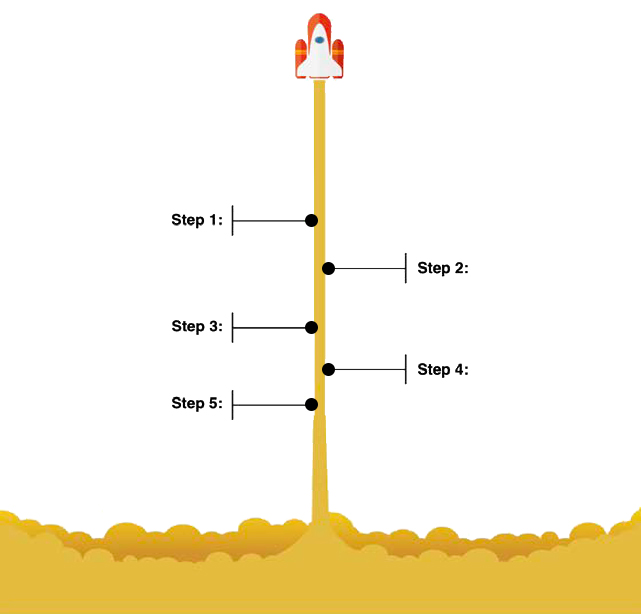
Step 1:
Identify your customers pain points
Step 2:
Define and declare your purpose
Step 3:
Develop strategies to achieve your purpose
Step 4:
Use moonshots to bring strategies and purpose life
Step 5:
Ensure psychological safety
Final Thoughts
You do not have to lead a big team, control a significant budget or be the owner of a tech start-up to do moonshots. Anyone, anywhere, at any level in any organisation can embark on a moonshot. All you need to do is have the courage to dare to strike out and find new ground.
Take Paul Cummins, a ceramic artist working alone in Derby, England. He went on a moonshot to create 888,246 handmade ceramic poppies for the art installation surrounding the Tower of London, commemorating the loss of every British and Commonwealth soldier who lost their life in The Great War. His moonshot inspired 25,000 people to volunteer their time and passion to make his dream a reality. Or, consider Sam McCracken, a Nike warehouse worker packing shoes into boxes. Sam – driven by the motivation of his mother being diagnosed with diabetes – embarked on a moonshot to make two million Native American’s more active and healthy. His moonshot adventure led to the launch of Nike N7, the first active wear specifically designed for the needs of Native Americans. Sam’s passion and commitment to his moonshot and how it inspired others led Nike executives to promote Sam to the MD of the now iconic N7 brand. But, more importantly, Sam and Nike are changing the lives of millions of Native Americans. Benefits abound for moonshooters.
Moonshooting quests are no longer the bastion of royalty and rich billionaires. Today anyone can embark on a moonshot that makes a meaningful difference.
Conclusion
The paradox of innovation is this: too often, organisations seek out a single magical innovation formula. Leaders then lock themselves into one type of strategy and say: “This is how we innovate.” They mobilise resources, energy and commitment, and for a while it works. But eventually – as articulated by Clay Christensen in the highly acclaimed Innovator’s Dilemma – the returns diminish. Organisations then find themselves locked into mindsets and methodologies which are no longer relevant to the realities of a changing world.
Organisations can avoid this innovation trap by recognising that at its core, innovation is about solving problems. The most innovative organisations are geniuses at discovering problems that nobody else realised existed.
Building a culture of sustained innovation into your organisation’s culture is the result of focusing on aspects which might at first may appear counter-intuitive. If all you want to do is come up with a few innovative ideas, then there are numerous brainstorming and innovation sprint methodologies available for deployment. But to build a culture of innovation, a systematic approach is required.
We call this approach Full Blown Innovation.
Rather than seeking to build an innovation pipeline full of creative ideas, this paper suggests focusing on building a spirit of curiosity centred around identifying your stakeholder’s most challenging problems.
To be successful, Full Blown Innovation has to be central to what you do and stand for. This is why building a culture around solving problems is such a powerful approach to an end goal of building a culture of innovation. To begin your journey, this paper recommends focusing on seven key essentials needed to deliver a culture of innovation:
-
Balance the business
-
Create shared understanding and ambition
-
Reward curiosity
-
Everyone participates
-
Create capable and accountable innovation leaders
-
Expansive Innovation
-
Measure what matters.
5. About the authors
Dean van Leeuwen
Founding Partner
London
Let's Connect
Ron Setty
Principle Accountant
Tel Aviv
Let's Connect
Graeme Codrington
Founding Partner
Johannesburg
Let's Connect
About TomorrowToday Consulting
Unlocking the potential of those who do well by doing good
For over two decades TTC has partnered with start-ups, middle market and progressive large organisations to develop the insights, impact strategies and culture of innovation that delivers growth and a better future for all stakeholders. We excel in the business of releasing human potential, this is where true strategic and competitive advantage exists. At the heart of everything we do is the optimisation of both social and business impact.

